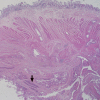Adenocarcinoma with intraductal papillary mucinous neoplasm arising in jejunal heterotopic pancreas
- PMID: 23109987
- PMCID: PMC3479704
- DOI: 10.4132/KoreanJPathol.2012.46.1.96
Adenocarcinoma with intraductal papillary mucinous neoplasm arising in jejunal heterotopic pancreas
Abstract
A 74-year-old man suffered from jejunal perforation and adhesion to sigmoid colon due to adenocarcinoma associated with intraductal papillary mucinous neoplasm (IPMN) arising in a jejunal heterotopic pancreas. The jejunal lesion showed direct extension to the sigmoid colon, which was mistaken as sigmoid colon cancer by surgeons. Malignant transformation is a rare complication of a heterotopic pancreas. About half of malignancies in reported cases were ductal adenocarcinoma arising in the stomach, and the jejunal location is extremely rare. Furthermore, IPMN is also uncommon finding in a heterotopic pancreas.
Keywords: Adenocarcinoma; Heterotopia; Jejunum; Pancreas.
Figures






References
-
- Chen HL, Chang WH, Shih SC, Bair MJ, Lin SC. Changing pattern of ectopic pancreas: 22 years of experience in a medical center. J Formos Med Assoc. 2008;107:932–936. - PubMed
-
- Cattell RB, Warren KW. Surgery of the pancreas. Philadelphia: W. B. Saunders Co.; 1953. pp. 26–37.
-
- Pearson S. Aberrant pancreas: review of the literature and report of three cases, one of which produced common and pancreatic duct obstruction. AMA Arch Surg. 1951;63:168–184. - PubMed
-
- Chen HL, Lin SC, Chang WH, Yang TL, Chen YJ. Identification of ectopic pancreas in the ileum by capsule endoscopy. J Formos Med Assoc. 2007;106:240–243. - PubMed
LinkOut - more resources
Full Text Sources

